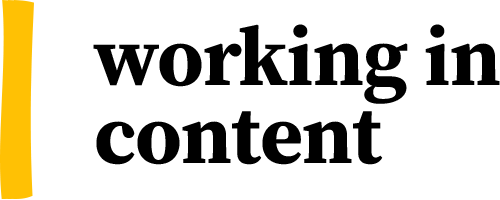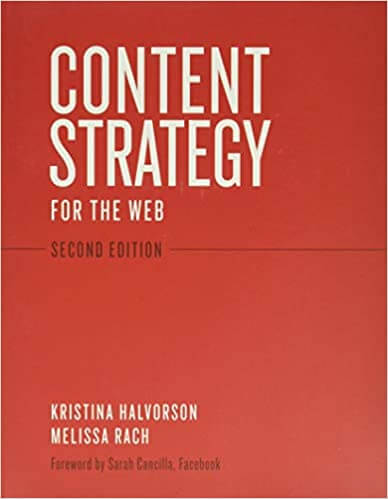On this page:
The marketplace demand for content strategists isn’t abating any time soon. Here at WorkingInContent.com, we can confirm that demand’s alive and well judging by the consistent flow of content strategy roles featured on the site. At the time of writing, c.700 organisations are hiring in the UK alone.
If you’re a content person trying to work out how to make the transition to your first content strategy role, or an established content strategist who’s looking for more progression, we’ve got you covered with this career advice-focused article.
We chatted to a number of senior content strategists from a number of different sectors, and asked them to share their experiences, tips and advice with us on everything from starting out in content strategy, securing that first role, and how to prepare yourself for more senior roles.
So get ready to read some wise words from the likes of Emily Hare (Publicis), Mike Petroff (Harvard Business Publishing), Sally Bagshaw (Canva), and Jemma Thomas (Lloyds Bank)…
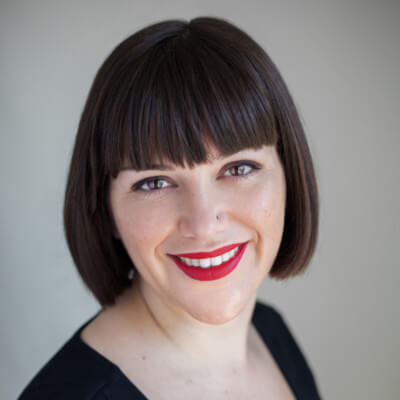
Starting out in content strategy
If you’re a budding content strategist looking for your first official role, you may be wondering whether it’s a hard road to get there. We can tell you that it is absolutely possible for you to make that leap from an existing non-strategy role to this kind of position.
Wondering how? Read on for some sage advice and helpful tips from our senior content strategists on this very subject.
Question #1
For someone considering a career change into content strategy from say, a more traditional role in marketing, journalism, etc., what should they know upfront/what advice would you personally give them?

“Investigate the definitions and boundaries of content strategy (see Kristina Halvorson and Rahel Anne Bailie’s sites and books) and content design (visit the futurelearn and Government Digital Service sites).
“Clarify in your own mind which of the two you lean towards most – then launch in that direction.
"In my opinion, a good editor makes a good content strategist; the editorial instinct and the planning instinct are core assets to have."

“I moved into content strategy from a journalism background, so I can really relate to people considering this kind of switch.
“I’d say that lots of the skills you have built up so far in those kinds of roles will be really relevant and valuable for content strategy; whether that’s crafting press releases, learning about new social platforms, or writing a long-form article.
“I’d advise them to think about what aspects of their current role that they enjoy most, and look for ways to maximise those – perhaps in the skills that they’re using or the elements that they focus on.
“I’d also say that content strategy is a broad and not particularly ‘descriptive’ term; it can encompass a huge range of elements, such as ‘partnerships’, ‘social’, and ‘influencers’. It’s now starting to expand into aspects such as ‘e-commerce’ and ‘live streaming’.
“For me, that’s part of what makes this such an exciting area; new elements are always emerging and social platforms are constantly evolving. Therefore, it’s useful to learn as much as you can about new ways to connect with people through content, and how audience behaviours are changing.”

“I’d say that - like most of the more nuanced disciplines within the glorious mix that is marketing or PR or advertising etc. – figure out how to talk about content strategy in a way that your mates would understand. Not your grandparents (i.e. you can assume a level of comms fluency!), but working out how you describe what you do when put on the spot in the pub is ‘step one’ in helping clients and employers understand how you are going to be useful to them, and helping them identify what they need now.
“You can pretty much guarantee they won’t necessarily be looking for a ‘content strategist’ from the outset, so you’ll need to help them get there.
“Also, have an opinion, and voice it. It’s what makes you interesting and relatable. The absolute joy of content strategy is that it’s a kind of communications anthropology, and almost any piece of storytelling falls under our watch. It’s not about putting pressure on yourself to spot the next big thing, just have a good think about how you feel about – for example – the latest social media platform, or the marketing funnel, or an analytics tool, or a new content trend, or a piece of award-winning work, or the behavioural science behind ad recall… whatever does it for you.
“Engage, have an opinion, and speak up. Frankly, you can’t really be a content strategist - wandering the globe drinking in all of the amazing storytelling out there – and not have a point of view on where the discipline is at, or where it’s going (or at least I can’t. Maybe I’m boring my pub audience after all).
Next, we asked our content strategy experts how they thought someone without any specific content strategy experience should approach making any examples they’re asked to give in an interview as relevant as possible.
Question #2
For someone looking for their first content strategy role, how can they persuade an interviewer (or recruiter) that they’re worth a shot?

“For starters, make sure you are familiar with content strategy, and with its core principles, activities and outputs, so you can discuss them intelligently with the interviewers.
“None of these are rocket science, and you should be able to cast back to corresponding activities and concepts from your past.
“For example, you may be able to quote:
- Excel work that would tie into content audits
- Training work or process documentation that would speak to editorial training
- (Re)writing or sub-editing work that would show off your penchant for clear writing.”

“I’m an advocate of applying for specific roles – where you really like the company or the client you’d be working on and their approach to content strategy.
“This is before the interview stage, but when I’ve been recruiting in the past, it’s obvious how many people have a generic cover letter and CV that they send to every single role on LinkedIn. That means it’s actually relatively easy to stand out from all those people if you’re prepared to go beyond ‘Easy Apply’ and put some time and effort into researching a role and come across like you genuinely want that job, rather than ‘any’ job.
“Specifically, when you’re applying for content strategy roles, think about how your experience will translate and be relevant for what you would be doing – don’t just list what you’ve done in the past, and expect the recruiter to make those connections for you.
“For example, have you worked with clients in similar sectors to the main clients that the agency has? Or can you mention a few credible articles or press releases that you’ve written, or campaigns that you’ve run, that tie back into essential qualities of the role you’re applying for?
“When you come to the interview, think about a few specific examples of projects that you’ve worked on that would be relevant to speak about – and you’ve been proud of. It’s fine if you’ve been a team member, rather than led the entire project, but think about what elements of that project you can say were genuinely yours, or you influenced, and be open about the role you played in the team and the results that achieved.
“Then, also think about what you can say that would make those examples relevant to content strategy at the agency or for a certain client. Most companies have their own processes and approaches that you’d have to learn, so showing that you have relevant knowledge and are happy to learn is important, especially if your background isn’t in content strategy.
“Also, don’t underestimate the power of enthusiasm for a particular platform or type of content. For example, what’s your take on a new piece of brand-created content? Are you always at the forefront of a TikTok trend, or do you use Snapchat as the primary way to stay in touch you’re your friends?
“Bringing your personality to life in a way that shows how connected you are to what you’d be working on and how quickly the category is evolving is another really positive way to stand out in front of potential employers. And, it’s something you can convey in both in your application and at the interview.”

“Give your opinion! Let your passion for the content mix and all the weirdness of why and how we consume stories come right to the fore.
“Also, let the work do the talking. A good content strategy positively shines through in the results. You can make the most amazing bit of content in the world, but without the right strategy in place – the right audience, channel, formats, and distribution – it can be a very expensive tree falling in the woods. Often it’s the difference between a campaign succeeding or failing, so focus on the work and where the results were good, however small. I always say that creating the content is only half the job.”
Starting out in content strategy: useful resources
-
Become a Content Strategist An online course you can find on LinkedIn.
-
How to create a successful content strategy A short, online course by HubSpot Academy.
-
What does a Content Strategist do? Examples from Facebook, Tesla and Microsoft A workingincontent.com article that runs you through all the basics of being a content strategist.
-
How to become a successful content strategist with these 9 skills Learn about the must-have skills that content strategists succeed in their job.
-
Content Strategist Job Description: Examples from SurveyMonkey, TikTok, and Amazon Our article breaks down and analyses some typical job descriptions.
-
Content Strategy: A primer for beginners. Katie Del Angel gives a nice introduction to the field in this recorded talk.
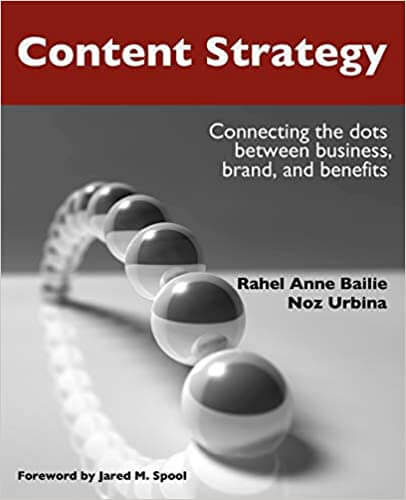 Content Strategy: Connecting the Dots Between Business, Brand, and Benefits
Content Strategy: Connecting the Dots Between Business, Brand, and BenefitsIf you've been asked to get funding for a content strategy initiative and need to build a compelling case, if you've been approached by your staff to implement a content strategy and want to know the business benefits, or if you've been asked to sponsor a content strategy project and don't know what one is, this book is for you.
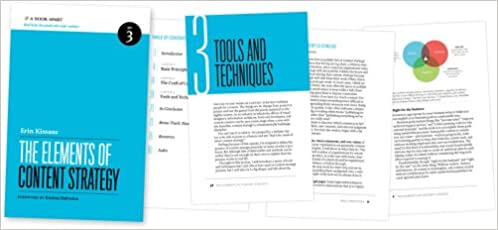 The Elements of Content Strategy
The Elements of Content StrategyThis is a short introductory book that covers what content strategy really involves.
Clinching that content strategy role
So, you’re on your way to applying for that new content strategy role. But, how prepared are you for the recruitment process, and do you have your portfolio in order?
Starting strongly is really important when you’re trying to make a good first impression, so we asked our senior professionals to think back to their own career path, and how they’d prepare for a content strategy role now if they were planning on moving jobs.
We also wanted to know what they thought a candidate could do to stand out as a frontrunner during the interview process.
Question #3
If you yourself were applying for a new content strategy role at this moment in time, how would you prepare?

“I’d write some case studies, based on my recent work. Writing case studies helps you to articulate answers for interview questions about your decision-making process, how you evaluate success, and growth opportunities.
“Also, I'd say it out loud. I'd ask a friend to join me for coffee or lunch and explain to them what I do. This kind of practice is important for interviewing for content strategy positions where you may be the only content strategist on the team.
“You should also be able to describe the impact you can make to an interviewer – even with limited knowledge of content strategy.”
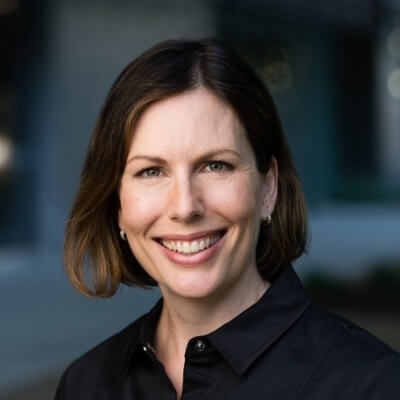
“Content strategy roles still vary quite a lot, so I’d do research about the company and find out what sort of work a content strategist does there.
“If it's aligned to what you're looking for, create a portfolio with case studies that are really going to resonate with them. Get into the habit of taking photos of workshops, or screenshots of your work, so you have some engaging visuals.
“Check that your examples show your process and the results… so for example, how did you break down a complex problem, formulate a strategy, and make an impact?”

“It may seem obvious, but I’d make sure that both my CV and supporting letter are really strong, accurate, and targeted to the role. After all, I’m selling myself as someone who can produce content that hits the right mark with the target audience(!).
“If there are spelling mistakes, or the hiring manager needs to do a lot of digging through my CV to find the right information, then I’m not doing content strategy very well – especially on a subject I should be an expert in. Me!”

“Dig into the business and its content. Not just what they’re doing today, but who is it for, and what’s its goal.
“Try to understand what the business wants to achieve from its content, and whether it has the strategy to achieve that. Then you can understand whether you’re pitching yourself as a revolutionary or evolutionary addition.”
Question #4
What skills do you believe make a content strategist stand out during an interview process?

“Be curious. Ask questions about the position and the company. Find out what lies beyond the edges of the job description.
“When I was hiring for open positions, it surprised me when candidates had zero questions during the interview. So, come prepared with questions like:
What’s your design process?
Which areas do you expect me to spend the most (and least) time on?
What mentoring opportunities are available within the company?
What do you think the company should be doing a better job of?”

“I’ve found that building relationships and networking are key strengths. Content strategists often have to gain buy-in from a number of areas; especially in large organisations.
"Being personable, being able to build strong working relationships, and managing – often challenging – stakeholders are crucial in a content strategy role."
“Personally, I know that my ability to flex my style (depending on who I’m working with) has been key in being able to navigate my way through large corporate organisations. It’s about thinking whether a certain stakeholder appreciates data and wants to delve into the detail, or whether they focus on customer experience and would want to know how this will be improved? Approaching presentations and projects armed with this knowledge has helped me gain support where needed, and allowed me to deliver on my content goals.
“So, during the interview process, you’ll find me armed with lots of examples of how I’ve worked in the past – and the results I’ve driven.
“Building a rapport with the interviewer/s quickly also helps to demonstrate your ability to forge working relationships. When I myself have been hiring, the final decision has often come down to that candidate’s attitude and personality. I look for people who have the right determination and approach, who can (and will) learn on the job and become invaluable members of my team.
“Figuring out what you do best, understanding how this relates to the role you’re applying for, and conveying this to the interviewer/s is the best way to stand out. It’s likely the other candidates will have a similar level of experience to you too, so any unique strengths you can convey could be what sways the hiring decision in your favour.”

“Being able to really tell a story around the impact of your work. I think it's easy to say, ‘Oh I did an audit of this, crafted a content model for that, developed a governance framework etc’, but why does that matter? Did you move metrics that were important for the user and the business? What were they? How did you measure them?
“Or, if you've been in a coaching/management role, how have you helped your team thrive? How did you foster a strong community of practice around your craft? How did you deal with tricky stakeholders or competing priorities?”

“Enthusiasm and an enquiring mind go a long way in this job. Ask questions, take an active interest in the subject matter (not just the strategic theory), and show you’ve done your homework. Go in ready to showcase yourself as a content strategist, but be open to the debate and discussion that can also go along with the role.”
Clinching that content strategy role: useful resources
-
Content strategy career advice Jon Burkhart talks about industry terms the key skills needed to survive as a content strategist.
-
Career advice from a freelance content strategist Alex Lemon gives tips about getting into the industry in this short interview.
-
8 Crucial Content Strategist Interview Questions Read these questions and answers to get a decent insight into the mind of a hiring manager!
-
How to Hire a Content Strategist Similarly to the above, here’s a chance to read a hiring manager’s perspective on recruiting and interviewing the best candidates.
-
Let’s put some strategy in our content strategies Understand the essential parts of what makes a good content strategy with this on-demand webinar recording.
Ready to take a look at the roles currently being advertised?
Accelerating your progression as a content strategist
Once you’ve been established in your role for a while, you may start to feel that itch for a promotion. But how do you get your foot on the next rung of the ladder?
These content strategists told us what they believed made someone a prime candidate for levelling up to a more senior role, as well as some pitfalls to watch out for...
Question #5
What should someone be thinking about and demonstrating if they want to move into a senior role?

“At any level, I'd always look to see evidence that someone has been pushing themself to learn new things and improve their skills.
“It could be by reading books or articles, going to conferences or meetups, asking questions of people who have skills and experience that you don't...this all shows that you're getting yourself ready for a step up.
“The other thing I think it's important to be able to demonstrate are 'soft' skills (which are actually really hard). Deep listening, empathy, persuasion, stakeholder management - these things are key in most senior content strategy roles.”
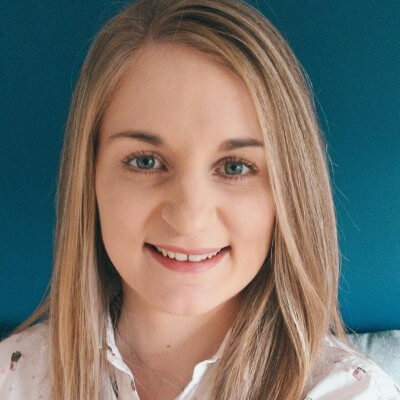
“Develop strong soft skills. They help to build your emotional intelligence, active listening, and empathy – which are key to good leadership.
“A handful to start with include:
Communication
Organisation
Teamwork
Critical thinking
Interpersonal communication
Adaptability
“Tell stories with laser-sharp understanding. The more storytelling skills you have, the better off you’ll be.
"If you can ‘walk the walk’ creatively, and understand the nuances of how to tell a product’s story intelligently, you’re ahead of the game as a content strategist."
“Great content strategy involves not only producing content but having a deep understanding of what resonates with audiences at the time.
“Also, don’t ignore B2B roles. The word ‘content’ carries ambiguity. It’s broad and can be used to describe several things. So, if you’re more focused on producing content for UX journeys (e.g., an internal application used by business users), then you want to be focusing on user stories, mapping user flows, wireframing, and prototyping.
“Writing content is one thing, but understanding user journeys is another. A great place to start is by chatting with a UX designer.”

“That's a good question! It's probably a mix of craft and leadership skills.
“Are you seen as an advocate for your craft? Do you share your work to raise the profile of its impact? Are you passing on your knowledge with others so they are making great content decisions as well?
“Moving into more senior roles usually means tackling more complex problems. So, have you shown that you are a strategic thinker? Have you identified opportunities to improve the content experience then rallied others to act on it?”

“As a content strategist, you need to think about the organisation as a whole and how content helps the organisation interact with their audience (and vice versa).
"Great content is a two-way street. You need to recognise and understand what subject areas your organisation has the authority to speak about, and what powerful, authentic content looks like."
“And always, always, always remember that content and channels are not the same thing.”
Lauren MacNeish mentioned the importance of ‘storytelling’ above, and this is a skill we can relate back to something quite important in the application process – and that’s possessing a strong portfolio... a portfolio that allows you to tell stories about your experiences, demonstrate your skills, and evidence your successes.
By the time you’re feeling ready to take things ‘up a gear’ professionally, you might have many projects and pieces of work you can draw on for this purpose.
If you’re looking for tips on how to collate an impressive portfolio, read on to find out what experts from Weber Shandwick and Publicis, amongst others, would recommend.
Question #6
For people who have already been working in content strategy: what advice would you give to someone piecing together/updating their portfolio?

“For your portfolio, I’d focus on the areas that you want to be working on in the future. Make sure that those are the areas that stand out in your portfolio; particularly if in your next role you’re looking to build on what you’ve done so far, rather than just do something similar but at a different company.
“If there’s something that you had great results for or was incredibly successful – but you hated working on it – consider whether that’s the best piece to include.
“For example, if you were asked about it at an interview, would you be enthusiastic and energised, or come across like it was painful, difficult and unenjoyable? Interviewers are also trying to decide who would be a good team member and a great person to work with every day, so you want to give yourself the best opportunity to share that.
“Consider building a flexible portfolio, so you can share one that is specific to the role you’re applying for, or call out a few pieces of work. The likelihood is that no one will have time to review your entire portfolio when it’s shared as part of your application, so think about making things as easy and efficient as possible for the people who’ll be going through applications to give yourself the best chance to stand out.
“Also, if you’re a content strategist at an agency where you’re established, maybe think about whether you need to move to get the experience you’re looking for. Can you speak to people – either your manager or leaders of other teams – to see if there are projects you can support on and people you can work with to gain more experience and try out new aspects of content strategy without having to make a big change? Often, if you’re open about what your goals are and what you’d like to work towards, and people around you know about it, you will see opportunities open up. Then it’s up to you to seize them.
“And if you don’t manage to move into that team or department longer term, you’ll have built up your portfolio in a relevant new area, and will be able to demonstrate more experience, as well as genuine enthusiasm and drive, in any job interviews.”

“First, make the effort to expose yourself to as many different types of projects as you can – from websites and social media to mobile apps and intranets.
“Then, with those in your back pocket, focus on the activities that you have found that you enjoy. There are too many ‘branches’ to content strategy to be able to do them all to a high level. So become especially good at, for example, taxonomy or training or branding or user research and you will build a reputation and demand for those things. Then you’ll get paid for doing what you love (hurray and... ker-ching!)”

“Showing an ability to get down to the practical implementation almost always wins over a client or employer. They need to feel like they’re in safe hands letting you bring their story to life.
“That could be an example of translating a beautiful piece of creative into multi-channel formats, or where you may have doubled down on an audience or channel because the data told you that was where you could have maximum impact, or – and this is always evolving and not the easiest thing to do – where the content rollout can be directly attributed to better business results like Share of Voice or MQLs.”
One thing about the nature of our industry is that there are a number of flourishing, active content communities in existence; whether it’s on a messaging app like Slack or on a social media platform like Twitter or Facebook.
Being an active member of these kinds of groups can really help you network, find support from your peers and make useful contacts for future job opportunities.
But where do you start?
Question #7
People can struggle to market themselves. What suggestions do you have for those who want to become more visible in the community?

"Find time to create something and put it out into the community. You’d be amazed how welcoming and encouraging other creators are – which will only encourage you to do more.
“By that token, be present in the community sense as well. Offer others the encouragement you crave, too. If you’re positive in putting yourself out there, I’m sure you’ll find that positivity comes back to you too.”

“Show your work. Start by writing. Write about your current work. Write product or UX flow teardowns. Write about your process in finding a job. Write for yourself and don’t chase an audience. You’ll find your voice in the process.
“Network. Start by volunteering for UX meetups and communities. Avoid leading with an ask and start with an offer. You’ll show your value and drive and others should notice.
“Over time, you’ll have people in the industry looking out for you, and referring you to open positions they know about.”

“Building visibility and credibility is difficult, takes time and requires a multi-pronged approach.
“LinkedIn is becoming more popular and more widely used, and there are a number of groups and communities you can join to widen your professional reach and network. Responding to LinkedIn connection requests and messages, and following or connecting with the right people will help this. Networking is key.
“There are also many events and networking opportunities in the content space. Picking the right ones to attend and/or speak at will help build up your profile. Over the last couple of years, this has become a lot easier, as visiting events doesn’t involve travel or as much of a time commitment now virtual events have been fully embraced.”
Content strategy communities you can join:
There’s also this amazing list of content strategy meetups, by location.
General advice for content strategists
We’ve covered a lot of ground so far, thanks to our senior industry experts. To recap, we’ve discussed subjects such as:
-
Clinching that first role
-
Making the transition from another field into content strategy
-
Nailing that interview
-
How to progress to a senior content strategy position
Now we’re going to ask our content strategy pros to reflect directly on their own personal career experiences and impart some advice based on what they’ve learned during their career to date.
Question #8
Are there any expectations you had about this career path that you have found different to reality, in either a good or negative way?

“In some ways, I had a charmed experience in my first content strategy role. I worked in an agile environment with collaborative designers, developers, and product managers who wanted my input.
“I thought it would always be like that, and I couldn't understand why so many people complained about the content being left until the last minute.
“Obviously, I got the rude awakening I deserved! In my next role, it turned out to be much harder to get a seat at the table for content than I expected.”

“The one thing that started to dawn on me slowly but surely throughout my career is that in a lot of cases (and particularly in agencies) the further up on the ladder you go, the less of your job is actually doing what you really love (unless you’re incredibly lucky).
“As you go up the ladder in content marketing, you start spending more time on staff management duties, budgets, stakeholder management, etc. You have other people to execute your strategy, to make the plans, to create the work. And that can distance you from that creative buzz.”

“Accessibility should be at the forefront of everything you do. Use the clearest, simplest language you can. It’s not a check-box exercise. It’s about opening your content up so that’s available to all users.
"Accessibility isn’t all about screen readers and alt text. It’s about giving your users what they need, in the way they need it, on a channel they’re on, in a format that works for them."
“Also, know that you’re probably not going to be Carrie Bradshaw. If you can make a career in content that means you can afford a large apartment in New York City and daily lunches/dinners with your friends, then it should be you telling us your tips!
Question #9
If you could go back in time and give yourself a piece of advice early in your career, what would that be?

“Always remember that you probably aren’t the target audience, so be prepared to let go of an idea that you love if it’s not fit for purpose.
“Then, when you know that the idea is the right one for them, the best way to respect your audience is to be true to the idea. Authentic content can be any length and in any format – but it has to be the right length and the right execution for it to speak to the right audience. Don’t be lazy…”

“Know when to quit a job that's not right for you (or one that's not right for you anymore).
“All the signs will be there when it's time to go – trust your instincts, and don't cling on when you need to make a change. And, keep a record of everything you're doing and learning – it'll help you reflect on your development, and make it much easier to create a portfolio.”

“Relax and enjoy what you do because it’s easy to get caught up in the minor pain points.
“And, remember how hard you worked to get to where you are. On the days where things feel like a lot, pause for a breath. You’re doing a good job.”
General resources for content strategists
-
11 pieces of advice to guide your content strategy This piece by Writer.com brings together a collection of tips from industry experts including Hilary Marsh, David Dylan Thomas and Jonathan Colman.
-
Web Content Accessibility Guidelines (WCAG). The WCAG is the standard in regulations; a good thing for any content strategist to be familiar with.
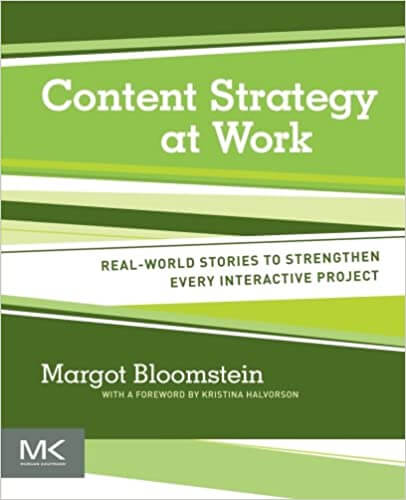 Content Strategy at Work: Real-world Stories to Strengthen Every Interactive Project
Content Strategy at Work: Real-world Stories to Strengthen Every Interactive ProjectThis book includes real examples of content strategy in action.
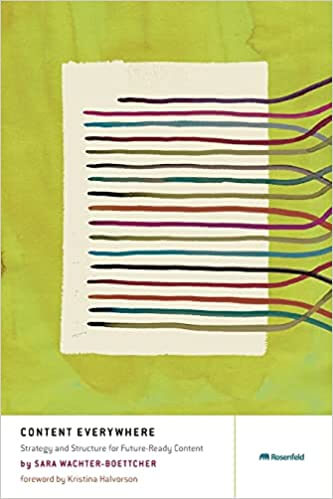 Content Everywhere: Strategy and Structure for Future-Ready Content
Content Everywhere: Strategy and Structure for Future-Ready ContentThis book looks at strategy and structure for future-ready content.
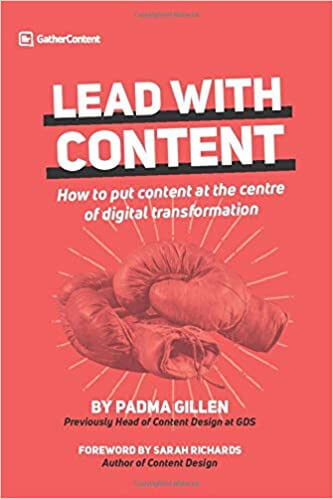 Lead with Content: How to put content at the centre of digital transformation
Lead with Content: How to put content at the centre of digital transformationPadma Gillen’s book is for content strategists who need to persuade their organisations about the value of user-centred content.
